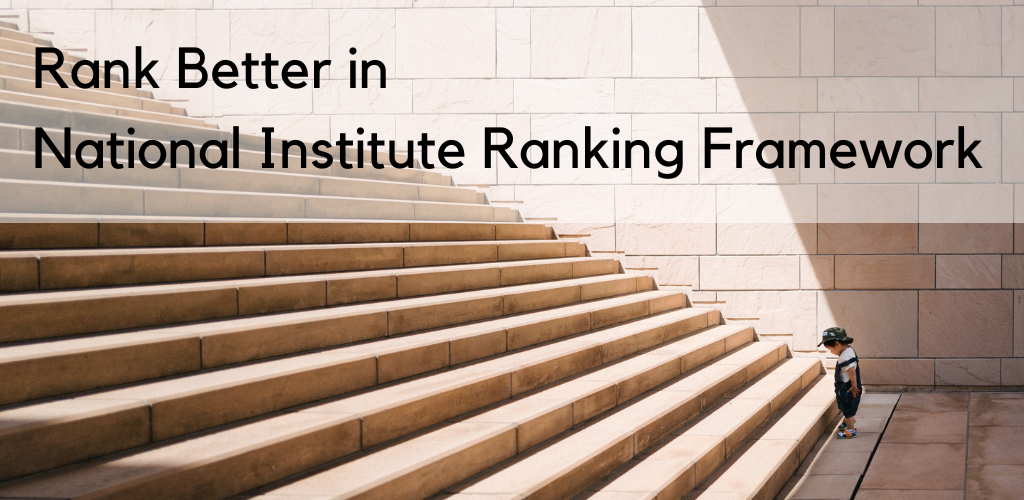NIRF rates institutions according to a framework that includes specific criteria and a system to evaluate their merits and demerits, as the name suggests. The Indian government has created the NIRF to assess how well higher education institutions are performing.

In India, there has been a sharp increase in the number of students enrolling in higher education. A study claims that the gross enrolment ratio (GER) at higher education institutions in India has achieved 26.3% and targets to achieve 32% by 2022. The quality of education being delivered in the nation is under pressure due to the extraordinary and ongoing growth in higher education institutions and student enrollment.
India's higher education system is not only extensive but also intricate and fragmented. The Government of India prioritizes the entire improvement of education delivery in terms of - accessibility, expansion, and excellence - to construct world-class educational infrastructure in the nation. In order to guarantee the desired quality, it establishes new benchmarks for the institutions. It is still a challenging effort to ensure sustenance even after setting up significant measures in judging the quality of education.
In addition to the required accreditations, the Indian government has created the National Institutional Ranking Framework (NIRF) to assess how well higher education institutions are performing. It rates institutions according to a framework that includes specific criteria and a system to evaluate their merits and demerits, as the name suggests. These rankings are not nationwide or historically comparable to those of the other universities in India. It's just to compare the institution's performance from the prior year to that of the other institutions in the same category.
The NIRF is based on five key parameters:
1. Teaching, Learning & Resources
2. Research, and Professional Practice
3. Graduation Outcome
4. Outreach & Inclusivity
5. Peer Perception
The following suggested practices can help improve the NIRF ranking.
Teaching Learning & Resources
Institutions must work to enhance teaching and learning methods and emphasize the curriculum. Every notable accomplishment of the institute's efforts and initiatives is closely examined by the NIRF. It delves into a number of other less obvious subjects, such as the creative curriculum. There are several approaches to improving teaching-learning practices, but the primary one is by developing a curriculum outline with a list of desired outcomes. Always keep the needs of the industry in mind while creating a curriculum.
If the institutions offer classes for vocational training in addition to the basic disciplines, it will aid the students to develop additional specialized skills that are essential for opening doors to possibilities. Additionally, this is a wonderful method of gaining recognition and moving toward adding your institution to NIRF India.
Research & Professional Practice
For institutions to increase their NIRF, the research must be of high quality, easily accessible, and citable. A combined metric for publications and for publication quality, IPR and patents, and footprint of projects, executive development programs, and professional practice are all integrated to establish the parameter of research in NIRF. It is also crucial to comprehend how to increase the influence of institutional research.
Institutional libraries are seeing an exponential increase in the number of research papers. It is essential for a researcher to set their work apart from that of other researchers with the same or a similar name. It affects the research output of an institution since a few faculty member-authored articles may be incorrectly attributed to a different author because of similar-sounding names. The solution to this issue is to produce results for the institutions' number of publications in the NIRF RPC (Research, professional practice, and collaborative performance) parameter that is accurate or correct.
Graduation Outcome
The ultimate goal of education is not to enhance knowledge but to provide children with the tools they need to be innovative and learn new things. The destiny of each institution is determined by the status of its graduating students. The number of graduating students who choose to pursue higher education, the level of university examinations, and placement records are only a few of the important variables that enable the NIRF Ranking Methodology to provide in-depth rankings.
Simply stated, this characteristic serves as a litmus test for the essential teaching and learning processes. This encourages educational institutions to focus more on output-based teaching methods rather of just using the age-old rote learning methods.
Outreach and Inclusivity
The city of Uttar Pradesh, an Indian State, is home to IIT Kanpur, which is renowned around the world for its academic prowess. The most crucial element in determining a college's rating is its outreach. If a college is good then it will attract students from the neighboring states but if the College is Best in the race then no doubt that the percentage of students from other states/countries will be more. The NIRF Ranking Board also takes into account the facilities and inclusiveness for other socially, physically, or economically challenged students when ranking a particular college.
Improving applications will entice the students and create a welcoming environment for learning and growth; and will ultimately attract students from different backgrounds, including those who are physically and socially challenged.
Peer Perception
By raising the institute's peer perception, one can significantly affect the institution's NIRF ranking. Perception score is based on the improvements in how employers, research investors, peer groups, academicians, and the general public perspective of the Institution. This can be accomplished through a concerted effort aimed at fostering an enabling environment for the students and faculty as well as ensuring equity in all aspects.
Building perception is largely dependent on digital presence. A dedicated staff or agency that manages an updated website and social media platform can help to boost perception, especially with the younger demographic. A carefully planned marketing effort for the institution will help to draw in the ideal students, build loyalty, and will help to alter perception.

.png)